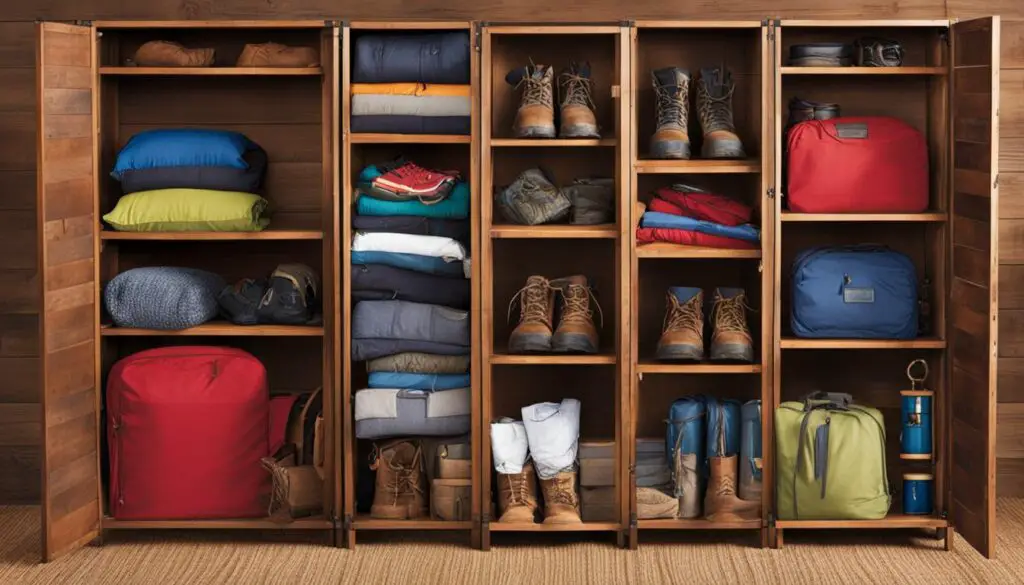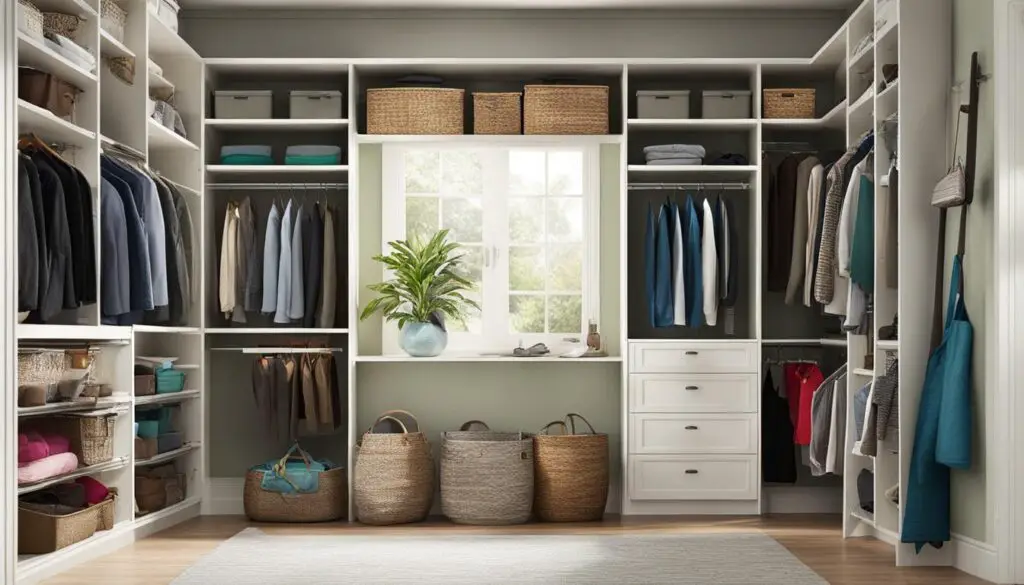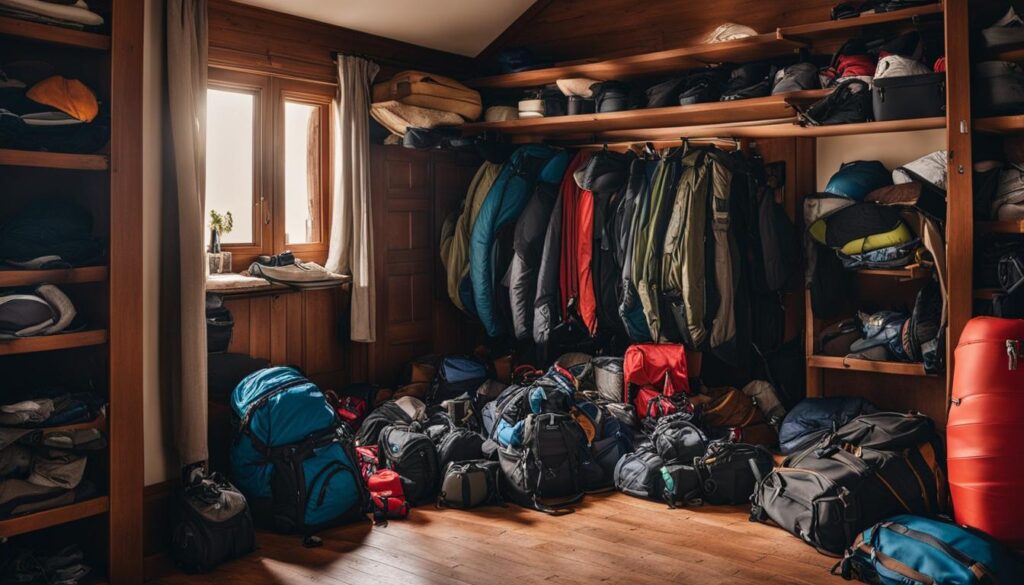Having a dedicated storage solution for your outdoor gear is essential for staying organized and ensuring everything is easily accessible. A closet bookshelf is a perfect option for neatly storing and organizing your outdoor gear. With the right approach, you can create a functional and aesthetically pleasing setup that showcases your passion for outdoor activities. Let me share some tips and ideas for setting up a closet bookshelf for your outdoor gear.
Table of Contents
Key Takeaways:
- Invest in a closet bookshelf to keep your outdoor gear organized and accessible.
- Assess your gear and purge any unnecessary items to create more space.
- Create dedicated spaces and utilize dead space to maximize storage potential.
- Use clear bins and gear separation techniques to keep your gear organized.
- Maintain the freshness of your gear by airing it out and regularly washing it.
Assess Your Gear and Purge Unnecessary Items
Before organizing your outdoor gear, it’s important to conduct a thorough gear audit and purge any unnecessary items. Taking the time to assess your gear collection will not only help you declutter but also ensure that you’re only keeping the items that are essential for your outdoor adventures.
Start by gathering all your outdoor gear in one place. This will give you a clear visual of how much gear you have and help you identify any duplicates or items that haven’t been used in a while. As you go through each item, ask yourself if it’s something you regularly use or if it serves a specific purpose. If you haven’t used an item in the past year or two, it may be time to let go.
Once you’ve identified the items you no longer need, consider donating them to outdoor gear consignment shops or selling them through online platforms like Craigslist or Facebook. Not only will this free up space in your closet bookshelf, but it will also give someone else the opportunity to enjoy and make use of gear that you no longer need.
| Benefits of Gear Audit and Purge |
|---|
| 1. Maximize space: By getting rid of unnecessary items, you’ll free up valuable space in your closet bookshelf for the gear you actually use. |
| 2. Streamline organization: With a smaller collection of curated gear, it becomes easier to keep everything organized and find what you need quickly. |
| 3. Financial gain: Selling gear that’s in good condition can help you recoup some of your investment and fund new outdoor gear purchases. |
| 4. Clearer focus: By purging unnecessary items, you can focus on the gear that truly brings you joy and aligns with your outdoor activities. |
Remember, the goal of a gear audit and purge is to create a more streamlined and efficient storage system. By letting go of items that no longer serve you, you’ll be able to make the most of your closet bookshelf and have a well-organized space for your essential outdoor gear.
Dedicated Spaces and Creative Solutions for Outdoor Gear Storage
When it comes to organizing your outdoor gear, creating dedicated spaces and utilizing creative storage solutions can make all the difference. With a closet bookshelf, you can optimize your storage space and ensure that everything is easily accessible when you need it. By thinking outside the box and making the most of every inch, you can achieve a functional and organized setup. Here are some tips and ideas to help you create dedicated spaces and utilize dead space in your closet bookshelf.
Create Dedicated Spaces
One of the keys to effective outdoor gear storage is creating dedicated spaces for different types of gear. This not only makes it easier to find what you need but also helps keep everything organized. Consider using labeled bins or baskets to group similar items together. For example, you can have one bin for hiking gear, another for camping gear, and so on. This way, you’ll always know where to find the specific items you’re looking for.
Additionally, you can use dividers or adjustable shelving to create separate sections within your closet bookshelf. This allows you to compartmentalize your gear and maximize the use of space. For larger items like tents or backpacks, consider using hanging storage bags or hooks to keep them easily accessible while still maintaining a neat and tidy appearance.
Utilize Dead Space
When organizing your closet bookshelf, don’t forget to take advantage of dead space. Look for areas that are currently underutilized, such as the back of the door or the sides of the shelves. Command hooks are a great tool for adding extra storage and utilizing these often overlooked spaces. You can hang items like hats, gloves, or even small backpacks on the hooks, freeing up valuable shelf or floor space.
Another clever way to utilize dead space is by using vertical storage solutions. Install a pegboard on one of the walls of your closet bookshelf and hang frequently used items like keys, headlamps, or water bottles. This not only keeps them within reach but also adds a touch of organization to your space.

With some creativity and a little bit of planning, you can transform your closet bookshelf into a dedicated storage space for your outdoor gear. By creating dedicated spaces, utilizing dead space, and employing clever storage solutions like command hooks, you can keep everything organized and easily accessible. Say goodbye to rummaging through piles of gear and hello to a functional and clutter-free closet bookshelf!
Keep Your Gear Organized and Fresh
Once you have set up your closet bookshelf for outdoor gear storage, it’s important to maintain organization and freshness. By following a few simple hacks and utilizing storage bins, you can ensure that your gear is always ready for your next adventure.
Separate and Organize with Bins
Bins are an essential tool for keeping your gear organized and easily accessible. Use clear plastic bins to separate and categorize your gear by activity or type. For example, you can have separate bins for hiking gear, camping equipment, and water sports accessories. Label each bin to make it even easier to find what you need, especially if you have a large collection of outdoor gear.

Utilize Gear Separation Techniques
To prevent your gear from getting tangled or damaged, utilize gear separation techniques. For smaller items such as socks, gloves, or electronics, consider using small zipper pouches or packing cubes. These can be placed inside your bins or directly on your closet bookshelf. Additionally, you can use dividers or adjustable shelf inserts to create separate compartments for different gear categories. This will help you find specific items quickly and efficiently.
| Gear Separation Techniques | Benefits |
|---|---|
| Zipper pouches or packing cubes | Prevents tangling and keeps small items organized |
| Dividers or adjustable shelf inserts | Creates separate compartments for different gear categories |
Refresh and Store Your Gear Properly
To keep your gear fresh and ready for your next outdoor adventure, it’s important to take proper care of it. After each use, make sure to air out your gear to prevent any odors or moisture buildup. For clothing and fabrics, follow the manufacturer’s instructions for washing and drying. To keep your closet bookshelf smelling fresh, you can place mild-scented dryer sheets or essential oil sachets among your gear. Additionally, storing your gear in a cool, dry place will help prolong its lifespan.
By implementing these gear storage hacks and keeping your gear organized and fresh, your closet bookshelf will become a functional and efficient space for all your outdoor essentials.
Conclusion
Organizing your outdoor gear with a closet bookshelf is a practical and efficient solution for keeping everything in order. By conducting a gear audit, creating dedicated storage spaces, utilizing dead space, and keeping your gear organized and fresh, you can optimize your closet bookshelf for outdoor gear storage.
Start by assessing your gear and purging any unnecessary items. This will create space for the essentials and make your closet bookshelf more efficient. Next, create dedicated spaces for different types of gear and get creative with storage solutions. Utilize underutilized areas in your home and consider using pegboards, shelves, and expandable closet organizers to maximize your storage space.
Once you have set up your closet bookshelf, keep your gear organized and fresh by using clear bins to separate and organize your gear by activity. This will make packing and unpacking more efficient. Don’t be afraid to use your gear to store other gear, such as using a bear canister to store camp kitchen gear. Finally, remember to air out your gear after each use, wash it regularly, and use mild-scented dryer sheets or essential oils to keep your closet bookshelf smelling fresh.
With a well-organized closet bookshelf, you’ll always know where your gear is and be ready for your next outdoor adventure. Follow these closet bookshelf organization and outdoor gear storage tips to maintain an organized and functional storage solution for your outdoor gear.
FAQ
Why is having a dedicated storage solution important for outdoor gear?
Having a dedicated storage solution for your outdoor gear is essential for staying organized and ensuring everything is easily accessible.
What is a closet bookshelf and why is it a good option for outdoor gear storage?
A closet bookshelf is a perfect option for neatly storing and organizing your outdoor gear. It provides a functional and aesthetically pleasing setup that showcases your passion for outdoor activities.
How should I start organizing my outdoor gear?
Start by assessing what you have and purging any unnecessary items. Go through your gear and pick out items that haven’t been used in the past year or two. Consider donating or selling these items.
How can I maximize the storage potential of my closet bookshelf?
Create dedicated spaces for different types of gear and get creative with storage solutions. Utilize underutilized areas in your home and consider using pegboards, shelves, expandable closet organizers, and command hooks.
How can I keep my gear organized and fresh?
Use clear bins to separate and organize your gear by activity. Consider using your gear to store other gear and keep it fresh by airing it out after each use, washing it regularly, and using mild-scented dryer sheets or essential oils.

